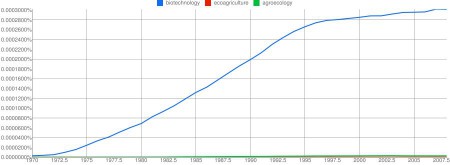- Biogeographic Information System Spatial Ecological Analysis of Megavertebrate Populations. Not agrobiodiversity by any stretch but stunning all the same, and a clarion call to our community to sort out Genebank Database Hell, surely.
- Traditional paddies as ecosystems. Great ones, too.
- Title says “seed banks susceptible to sham samples,” text says not really, and maybe it doesn’t matter much anyway. Our take from a few days ago.
- China’s millet useful in Africa. Which millet? Your guess is as good as mine.
- Cherimoya going seedless.
- Annex 1 list of International Treaty on PGRFA to expand? Well, maybe. Whatever, wow.
- Lecture materials on conservation and use of animal genetic resources.
- The ancient fast foods of Greece.
- Conserving heirloom apples. Nice gig if you can get it.
Thereby hangs a tale
Nibbles: Flora, Agronomy podcasts, Stats, GFAR, Horses, Lettuce, Churst forests, Brazil nut, Grassland diversity, Baobab, Flotation, Botanic gardens and invasives, Nutrigenomics
- Picture guide to West African plants. Includes agrobiodiversity!
- Iowa State Agronomy podcasts. Some cool stuff. Check out the one on “Modeling Seed Germination Over Time to Decide When to Regenerate Seed Lots in Long-term Storage.”
- A “formal global program to develop subnational agricultural land-use statistics“? Riiiiight.
- GFAR meeting on sustainable use of agrobiodiversity says “[w]e need to initiate solid and inclusive actions to build concerted and practical actions on sustainable use.” Well they do say actions speak louder than words.
- Researcher “trying to remove the perception that hackneys are ‘half-crazed.'” I’d rather pay to save them if they were crazy, but that’s me.
- Romaine: germplasm to breeding lines. But to cultivars? Private sector to pick up the slack.
- Crops not mentioned among species that save our lives.
- Saving sacred groves in Ethiopia. By building pit latrines. Well why not?
- Brazil nut spread by people.
- A trade-off between species and genetic diversity? Say it
ain’t so! - Today’s iconic species threatened by climate change is the baobab.
- An Egyptian archaeobotanical blog.
- Botanic gardens can threaten biodiversity.
- Nature has (or had, it’s a couple months old) a supplement on nutrigenomics.
Quality standards for in situ agrobiodiversity conservation published
This just in from Dr Jose Iriondo of the Depto. Biologia y Geologia, Universidad Rey Juan Carlos, Madrid, Spain. Do provide your input if you can.
One of the deliverables of the AEGRO project (AGRI GENRES 057), 1 funded by the European Commission, DG AGRI within the framework of Council Regulation 870/2004, is the formulation of quality standards for genetic reserve conservation of crop wild relatives (CWR). The quality standards are a guide containing a set of criteria for the establishment of genetic reserves within existing protected areas and a set of management standards to optimise the efficacy of genetic reserves as a tool for the conservation of CWR.
The current version of these quality standards is available. We are interested in knowing you opinion. Please send us your comments and suggestions. We would appreciate it if you would also disseminate this email to members of the Crop Wild Relatives community and Protected Areas community in your country for additional feedback.
The Genomics of Genebanks Workshop at PAG deconstructed
Greg Baute has a post up at his blog on the Genomics of Genebanks Workshop held last week at the Plant and Animal Genome Conference. Interesting observations on core collections, comparing past genebank collections to current diversity in the field, and the role of crop wild relatives in breeding. I particularly liked Cameron Peace’s advice on how to get the most from collections of wild relatives of fruit trees. Maybe we’ll hear more about that at Davis in March.

